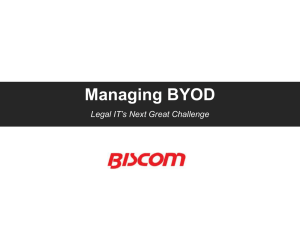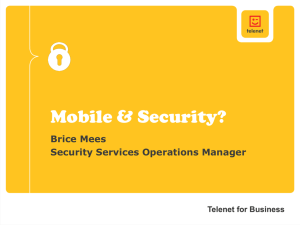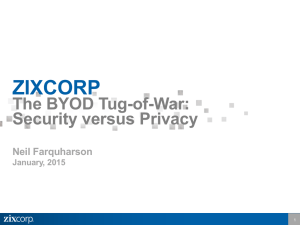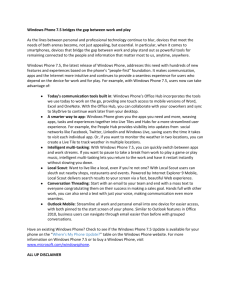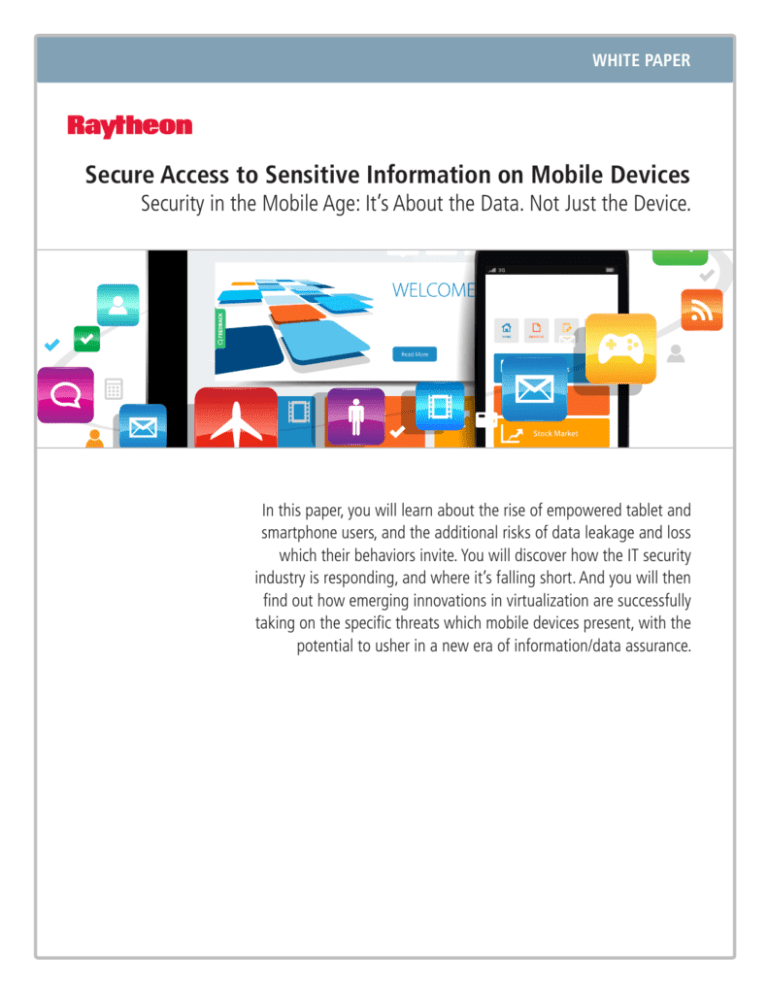
WHITE PAPER
Secure Access to Sensitive Information on Mobile Devices
Security in the Mobile Age: It’s About the Data. Not Just the Device.
In this paper, you will learn about the rise of empowered tablet and
smartphone users, and the additional risks of data leakage and loss
which their behaviors invite. You will discover how the IT security
industry is responding, and where it’s falling short. And you will then
find out how emerging innovations in virtualization are successfully
taking on the specific threats which mobile devices present, with the
potential to usher in a new era of information/data assurance.
WHITE PAPER - Secure Access to Sensitive Information on Mobile Devices
Contents
1. Mobility Brings New Cybersecurity Concerns
4
2. Industry Response Remains Incomplete
4
3. Essential Assets for Protection
5
4. Empowered Mobile Users Invite New Risks
5
5. Falling Short of Complete Assurance
6
6. Virtualization Solutions Help Resolve the Security Equation
7
7. Raytheon Trusted Access Mobile
7
8. A Comprehensive Mobile Security Strategy for the Present...
Promising Development for the (Very Near) Future
8
References
https://blog.lookout.com/blog/2011/03/01/security-alert-malware-found-in-official-android-market-droiddream/
http://www.zdnet.com/first-case-of-android-trojan-spreading-via-mobile-botnets-discovered-7000020292/
http://blog.malwarebytes.org/mobile-2/2013/09/obad-trojan-found-in-fake-google-play/
http://mobithinking.com/blog/mobile-web-penetration
http://www.emc.com/leadership/digital-universe/iview/executive-summary-a-universe-of.htm
http://www.cnn.com/2012/09/10/tech/mobile/our-mobile-society-intro-oms/
http://www.gartner.com/newsroom/id/2466615
http://newsroom.cisco.com/release/854754/Cisco-Study-IT-Saying-Yes-To-BYOD
http://www.slideshare.net/citrix/citrix-mobilityreportbyod2014
http://www.navisite.com/download-daas-survey
http://www.itbusinessedge.com/cm/community/features/interviews/blog/employees-bypassing-it-as-byod-takeshold/?cs=50441
800.230.1307
3
WHITE PAPER - Secure Access to Sensitive Information on Mobile Devices
Mobility Brings New Cybersecurity Concerns
In 2011, a malware attack named DroidDream infected more
than 50 popular mobile applications – including business
tools such as a file manager, scientific calculator and advanced
currency converter – to take control over devices and steal
sensitive data. Then, in 2012, news reports revealed that “Red
October” had been stealing hundreds of terabytes of sensitive
data from mobile devices and other entry points, impacting
business and government users in 36 nations, including the U.S.,
Russia and Iran.
Research demonstrates that threats impacting smartphones, tablets and other mobile devices are rising
quickly. User behavior is adding to the risk of data
leakage and loss:
The appearance of new mobile malware – almost
exclusively focusing on the Android platform – grew by
33% over a six-month period last year, while new
malware targeting PCs remained nearly flat.
Last year, a Trojan named Obad created a bogus Android Google
Play store to launch botnet-enabled malware distribution on
mobile devices, granting itself extraordinary administrative
privileges which were extremely difficult to undo. In fact,
Kaspersky Labs described Obad as the “most sophisticated
Android Trojan yet.”
83% of organizations indicate that mobile devices overall
create a high security risk.
These and other incidents underscore a sense of urgency when
it comes to mobility, security and the enterprise. And, make no
mistake about it, the Mobile Age has just begun: About nine of
ten Internet users will access the Web from smartphones, tablets
or other mobile devices by 2017, up from about three-quarters of
users in 2013, according to eMarketer.
32% of all mobile threats are launched for the primary
purpose of stealing information.
60% of employees admit to engaging in some form of risky
behavior on the devices they use for work, and one-third
download malicious apps, documents or other files.
73% of organizations are either “very” or “extremely”
concerned about loss of their data on mobile devices.
Sources: Cisco, McAfee, Symantec, Webroot
But security remains a pressing source of concern. The rate of
growth of new mobile malware primarily targeting smartphones
and tablets is far outpacing that of PC-based attacks. As using
personal products for work purposes continues to build
momentum this trend is sure to continue. Thus, organizations
face new exposures in terms of data leakage and loss. For these
organizations, sensitive and/or proprietary data and information
represent their most precious asset. In the wrong hands, the
fallout from an incident in which device-contained data and
information are compromised can be crippling.
In this paper, you will learn about the rise of empowered tablet
and smartphone users, and the additional risks of data leakage
and loss which their behaviors invite. You will discover how
the IT security industry is responding, and where it’s falling
short. And you will then find out how emerging innovations
in virtualization are successfully taking on the specific threats
which mobile devices present, with the potential to usher in a
new era of information/data assurance.
www.raytheoncyber.com
Industry Response Remains Incomplete
To combat the growing concern of security around mobile data
access, industry has introduced an assortment of technologies –
walled gardens, application white listing, data wiping and similar
concepts with limited success. Mobile Device Management
(MDM) has gained perhaps the most attention, albeit, MDM is
somewhat mislabeled as a security solution given that its main
purpose is device provisioning, management and optimization.
Nevertheless, the allure of MDM has reached a zenith; there
are nearly 130 vendors in this space. Not to dilute their utility,
but surely differentiation and manageability would be difficult
considering the vast number of MDM offerings and the diversity
of devices for which they’re acquired.
Upon further review, it’s obvious that the sheer volume of
devices and their variants demand greater protective assurances
than these responses can provide on their own. These solutions
are designed with a sole purpose: to ensure that data on the
device is not misused, stolen, lost or leaked. The data, however,
still resides on the device.
4
WHITE PAPER - Secure Access to Sensitive Information on Mobile Devices
The same thesis applies to secure containers – another
application-layer solution which purports to keep apps and
data within a designated area at a device-centric level. True,
containers offer a better approach than MDMs, but they still
do not establish the assurance needed for private, sensitive or
classified information as they, too, are focused on the device.
Any concession at the OS level below the stack of the device
will blow apart the data.
Ultimately, mobility solutions must protect the data first and
foremost, as opposed to the device.
Fortunately, there are emerging, virtualized technologies
that directly address this need, to secure data as is resides in
the enterprise. As a result, devices are treated as just another
endpoint, which is what they are. It’s the data that really matters.
Essential Assets for Protection
First, let’s examine two key assets which any IT security effort
seeks to defend: data and applications.
Data. Practically every organization on the planet is a datadriven one: The digital universe is doubling every two years,
and will equate to 40,000 exabytes by 2020, according to IDC.
(A single exabyte of storage can contain 50,000 years’ worth of
DVD-quality video.)
But not all data is created equal. Each individual piece is defined
by its attributes. Beyond the meaning and the use of the data,
the attributes can define sensitivity levels, access controls and,
in military/intelligence circles, clearance classification (e.g.
“Unclassified,” “Sensitive But Unclassified,” “For Official Use
Only,” “Secret” and “Top Secret”). This has led to formal efforts
in data tagging, along with usage attributes. The higher data
sensitivity requirements dictate that certain agencies – particularly
those within the Department of Defense (DoD) and Intelligence
Community (IC) – ensure physical separation and put in special
safeguards for the storage, access and transfer of data.
Due to compliance mandates, private industry deals with similar
dynamics more frequently these days. Regulations such as
HIPAA and PCI speak to the oversight of sensitive information
such as Personally Identifiable Information (PII). Additionally,
any corporate information – like disclosures related to financials
and the like – merit the same attention.
Applications. The Mobile Age gave us the very term, “apps.”
When we hear the word, we picture tech tools which value ease
of access to information from anywhere by anyone, regardless of
security considerations. This is fine for consumer apps (at least
800.230.1307
until something goes wrong); but not for enterprises, especially
when systems running mission-critical tasks are exposed.
(Because by the time “something goes wrong,” it’s too late.)
Web-based access further complicates the challenge. Nevertheless, with the right amount of policy enforcement,
ease of app usage can still be preserved.
The safeguarding of data/information and apps for remote users
introduces difficult questions:
How different are the needs for the protection of data/
information and apps today than they were in the premobility days?
Is securing the end-point the most effective way to fortify
sensitive information?
Are attributes and usage requirements the same for all data,
regardless of the degree of sensitivity?
Empowered Mobile Users Invite New Risks
A profound cultural shift among virtually all private
organizations and government agencies is further complicating
the topic. In decades past, senior management and/or the IT
department dictated to employees the kind of machines they
would use, right down to the make and model. They would
determine which software tools were allowed and which were
prohibited.
Well, mobility and its derivative – the Bring Your Own
Device (BYOD) phenomenon – coupled with the rising tech
sophistication of the general public – has changed this dynamic
in a hurry. The mass consumerism of technology has shifted the
power of choice to everyday users. They’re confident that they
know what devices and apps will maximize productivity. Frankly,
employees can “get their own way” on tech deployment because
organizational leadership cannot ignore the vast, businessbenefiting outcomes. IT, in turn, is transitioning into a somewhat
resigned, “can’t beat ‘em, join ‘em” stance.
Unlike alternative technology adoption processes in which
significant vetting takes place before any acceptance/deployment,
IT personnel are rushing to understand and react in some
manner, without stifling the adoption surge. These devices are
updated frequently with respect to software, OS, etc., making
it difficult to stay on top of it all. Frankly, this can keep the tech
department awake at night: What if a device with sensitive
information is stolen? What if users visit malware-infected
sites and links? What if they download highly suspect content,
opening the door to a network attack?
5
WHITE PAPER - Secure Access to Sensitive Information on Mobile Devices
What’s more, compared to computing products of just a few
years ago, devices today pack a big punch, capabilities-wise.
Time magazine once famously described the standard
smartphone running on an Apple iOS or Google Android
operating system as having “more computing power than Apollo
11 when it landed a man on the moon.” This means they’re quite
valuable, if not vital to accomplish mission-critical jobs. But this
increases their profile as targets of cyber threats. When such a
device is introduced into an enterprise, the primary concern is
security – especially as it relates to safeguarding information
which may be sensitive, classified and/or proprietary.
BYOD has gone mainstream, with tablets and smartphones leading this revolution. But the ensuing user
freedoms are leaving data more exposed.
95% of organizations allow for BYOD in some way.
Tablets will account for 54% of BYOD devices this year, and
smartphones for 50%. Only one-quarter will be laptops and
other computers.
80% of IT decision-makers feel BYOD is the “new normal.”
Two of five mobile workers use devices without the knowledge
or support of IT.
The average number of devices used by knowledge workers this
year will be 3.3, up from 2.8 in 2012.
By 2017, one-half of employers will require workers to supply
their own devices to get their jobs done.
Sources: Gartner, Cisco, Citrix, NaviSite, Juniper Networks
Falling Short of Complete Assurance
MDM, containerization, mobile hypervisors, dual persona
devices, etc. establish a certain layer of security. But when it
comes to classified or sensitive data, the protection required
grows exponentially. How comfortable would you feel if an IRS
agent works remotely, with your Social Security number and
personal records on his tablet, and then accidentally leaves the
tablet behind at Starbucks? Does it make you feel better if you
knew an MDM tool can wipe the device clean? Really? Even if a
thief can grab the information on it before the MDM solution
can remove the data? Or if the data is in a container that malware
can infect by compromising the operating system?
www.raytheoncyber.com
Device-centric solutions are not enough to assure a high level of
security when sensitive or classified data is accessed on the device.
We consider MDM and the aforementioned approaches as a
decent start. But with the challenges of potentially vulnerable
sensitive corporate data on so many different devices,
organizations are better served by protecting data at the source
instead of securing the plethora of devices.
HTML5/responsive Web design (RWD) has emerged as a mobiledevelopment option, as 43% of U.S. IT managers say they’ve
adopted both, according to research from Forrester. However,
many IT managers have concluded that mobile HTML5 apps are
slower than native mobile apps, with delayed updates and bugs
and an overall excessive amount of time spent on testing and
fixes, according to a published InfoWorld report. Additionally,
web apps fall short where rich user experience and response
are required. Ultimately, HTML5 and IT managers feel that it’s
best for small subsets of apps, such as internal lines of business,
according to the InfoWorld report.
Beyond security concerns, there are many logistical issues
presented by MDM, containerization and the other solutions.
BYOD has unleashed a Pandora’s Box for organizations, as IT
departments and leadership seek to establish usage policies, which
employees resist. They don’t feel the tech department and managers
have a right to dictate what they can and cannot do with their
devices. Who owns the device anyway – the company or the users?
Then, there are the immense burdens placed upon IT
administrators. Devices and operating systems continue to
proliferate and admins can’t keep up – again, because they are
deploying device-centric tools, not data-centric ones.
This sets up a perfect storm of troubling questions which options
like MDM and containerization fail to sufficiently answer: How
many devices can an enterprise manage before it becomes too
complex? Given the fundamental change the mobility paradigm
brings to the workplace and lessons learned from end-point
security, is it time for a different approach? Most importantly, is
the assurance established by these solutions enough and do they
accommodate all types of data – unclassified and sensitive – in all
types of situations?
Of course, the only 100% certain way to address every potential
problem – including the elimination of data leakage and loss – is
to entirely ban the storage of work-related, sensitive data or apps
on devices. But that isn’t going to happen. As the saying goes, the
genie is out of the bottle and he’s not going back in.
6
WHITE PAPER - Secure Access to Sensitive Information on Mobile Devices
Virtualization Solutions Help Resolve the Security Equation
In the Windows workstation world, there’s Virtual Desktop
Infrastructure (VDI) software, which separates the desktop
environment and apps from the client used to access it.
There are many advantages associated with VDI, including
reduced administration, enhanced security and decreased
power usage. Users connect to their Windows environment,
which resides securely in the cloud as opposed to the desktop.
If anything happens to the desktop, critical or sensitive data is
not compromised.
In other words, virtualization is about safeguarding data, not the
machine. VDI is quickly gaining in terms of public and privatesector deployment, as Gartner estimates virtual desktops account
for 40% of the entire PC market.
But VDI in and of itself falls short in terms of its usefulness
within the mobile environment. Primarily, desktop applications
are optimized for a keyboard-and-mouse environment while
mobile devices sport more interesting options.
But the concepts behind virtualization need not be lost
altogether. By virtualizing the native mobile apps themselves
and securely redisplaying them on a tablet or smartphone,
these technologies can be optimized for the mobile world.
This is referred to as Virtual Mobile Infrastructure (VMI).
VMI takes advantage of virtualization and redisplay technology
to extend access to sensitive information from a commodity
device without elevating risk.
VDI attempts to make the mobile transition. But it can’t because
desktop apps are designed for Windows environments. To
receive the necessary mobile support, executive leaders must
turn to VMI, protecting not only public but sensitive/classified
data at the source as opposed to the device. (VMI, like VDI, is
safely secured in the cloud)
There are additional advantages: Those logistical complexities
mentioned previously disappear. IT admins don’t have to oversee
an ever-increasing number of devices and operating systems. With
VMI, they focus on the data residing in the cloud. As for those
devices, they are just endpoints, nothing more. Administrators
streamline user/device registration while publishing and managing
apps from a central point of management. Cost savings are
considerable, as you won’t have to target multiple platforms for the
same app.
800.230.1307
VMI is BYOD-friendly too. Since data and apps never reside on
the device, there is no need for extensive legal policies to address
data wipes and separation of personal and mission-intended apps.
VMI controls access across the mobile continuum – from the
device to the back-end through policy enforcement customized
for the enterprise. Enterprises decide who gains entry to what
apps and data, based upon not only their identity but other
factors such as location. It does not replace an organization’s
MDM solution, nor is it dependent on a particular MDM
product. It can function as simply another part of a mobility
management ecosystem.
Raytheon Trusted Access Mobile
For organizations requiring access to sensitive data and
applications at either single or multiple classifications, Raytheon
enables secure access and interactions with data from any
location on mobile devices. To advance beyond container and
MDM-based protection/remediation technologies, Raytheon
virtualizes native mobile and other types of applications in a
secure infrastructure and leverages redisplay technologies for
user interactions, thus alleviating concerns of data loss, theft
and compromise.
Specifically, Raytheon has developed Trusted Access Mobile,
a VMI platform with a secure-access framework and a virtual
mobile-device infrastructure. The framework manages
identity tokens, secure network communications, access policy
enforcement and contextual awareness, with a virtual mobile
app management and hosting service which end users access
via redisplays.
Figure 1
Sensitive data and apps are secured on the back-end.
The mobile user is granted entry to protected resources
hosted on the virtualization platform after authentication.
Once authenticated, the user is allowed access to resources based
on access control dictated by policy that can be applied based on
contextual awareness.
7
WHITE PAPER - Secure Access to Sensitive Information on Mobile Devices
Virtual mobile apps are protected on the device, where they are
immune from any tampering or exploitation that might occur on
a compromised edge device. Enterprise data is accessed by the
virtual mobile apps only, so sensitive and proprietary data never
leave the protected network. There is no potential for a malicious
app on the edge device to opportunistically scan the enterprise
network.
Figure 2
As with desktop systems, Trusted Access Mobile allows for the
enterprise computing system to audit and detect questionable
user behavior. The virtual mobile device runs on enterpriseowned hardware in the back-end and is owned by the enterprise,
so there are no legal or technical impediments to deep audit/
detection instrumentation being applied to the device.
A Comprehensive Mobile Security Strategy for the Present...
A Promising Development for the (Very Near) Future
We want to stress that we are not criticizing current technologies
discussed in this paper. Many are good at solving some of the
problems. But we must take the next step forward, to always
think about protecting the data first, as opposed to the device.
That’s where VMI is emerging as a preferred technology
approach. It establishes the highest standards of security, while
allowing mobile users the flexibility they seek. They’re able to
deftly manage the mix of sensitive and non-classified data/
information.
Through these technologies, organizations will have every
opportunity to deliver the best of both worlds: Ease of user
function, the capability to communicate in real time, regardless
of clearance, and a fully secure mobile environment. That’s what
a “protect the data” strategy versus protecting just the device – is
all about.
Written by Ashok Sankar, Raytheon Cyber Products
Ashok Sankar is Senior Director, Product Marketing Strategy at Raytheon Cyber
Products, a technology and innovation leader specializing in defense, intelligence,
civilian, and commercial markets throughout the world. Its product, Trusted Access
Mobile provides defense-grade security to protect critical, sensitive, and proprietary
data. It is fully compatible with solutions from leading vendors such as VMware®
In summary, here’s why organizations need Trusted Access
Mobile:
and Citrix®.
It’s ideal for Bring Your Own Device (BYOD).
It co-exists with existing MDM and Mobile Application
Management (MAM) solutions.
It enables customers to conduct confident and cost effective
collaboration.
It provides access to sensitive, confidential, or proprietary
data.
It protects against data loss and compromise prevention.
It allows access to native, desktop and web apps.
For further information contact:
Intelligence, Information
and Services
Cyber Products
12950 Worldgate Drive, Suite 600
Herndon, Virginia
20170 USA
866.230.1307
www.raytheoncyber.com
All other trademarks and registered trademarks are property of their respective owners.
Customer Success Is Our Mission is a registered trademark of Raytheon Company.
Cleared for Public Release. Internal Reference #IIS2014-055
Copyright © 2015 Raytheon Company. All rights reserved. - 300125.0415



